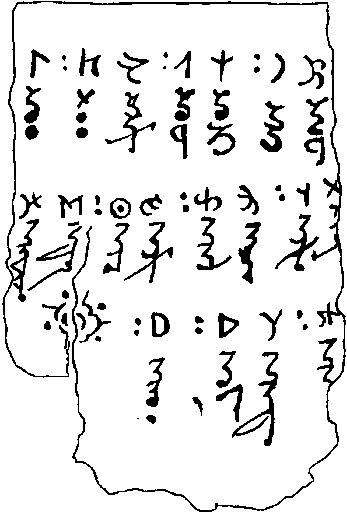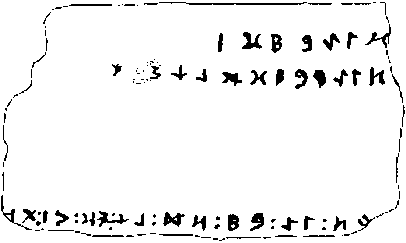Orkhon Alphabet
Oldest Known Alphabet Manuscripts
The manuscripts containing portions of the Türkic alphabet were re-published in the work Writings of Eurasian Steppes by I.L.Kyzlasov.
We do not know the name for the "letter" or for the "alphabet" used by the Türkic writers. Two fragments of the East Turkestan manuscripts, with partially preserved records of the Türkic alphabet, were found and published. Both came from the ruins in the valley of the river Tonok (Tuyuk) in Turfan. The first was found at excavations by A. von Lekok in 1905 and published in 1909: Toyok, Berlin Museum of Indian Art storage code T II. T. 20 (Fig.10). The second was acquired in 1908 by the expedition of Otani Sesin and published in 1961, it is in the library of the Rukoku University in Kyoto (No 8129) (Fig. 11). O.F.Sertkaya compared the documents, noted the common order of the letters of both records, and tried to establish number of characters in the alphabet by the filling of lacunas in the Toyok I manuscript with the data of the fragment from the Rjukoku library.

Fig. 11. Manuscript from Rukoku library. 8 c. AD. Reproduction by O.F.Sertkaya

I.L.Kyzlasov commentaries:
We do not know the name for the "letter" or for the "alphabet" used by the Türkic writers. Two fragments of the East Turkestan manuscripts, with partially preserved records of the Türkic alphabet, were found and published. Both came from the ruins in the valley of the river Tonok (Tuyuk) in Turfan. The first was found at excavations by A. von Lekok in 1905 and published in 1909: Toyok, Berlin Museum of Indian Art storage code T II. T. 20 (Fig.10). The second was acquired in 1908 by the expedition of Otani Sesin and published in 1961, it is in the library of the Rjukoku University in Kyoto (No 8129) (Fig. 11). O.F.Sertkaja compared the documents, noted the common order of the letters of both records, and tried to establish number of charachters in the alphabet by the filling of lacunas in the Toyok I manuscript with the data of the fragment from the Rjukoku library.
The Toyok I manuscript is accompanying the Türkic letters with the Manichean letters, and the fragment from Rukoku library has a triple record of alphabetical entries. Unfortunately, both miss the beginning of the alphabet, and the blanks in the three lines of the Toyok fragment create lacunas in the middle of the list, the third line of the Rjukoku library manuscript does not have the end, and the first two lines are incomplete. Nevertheless a comparison of the documents to make important observations.
First of all these are the monuments of the Orkhon writing. By the paleographic characteristics, these two documents are attributed to different stages of the existence of the Türkic writings: the fragment from the Rukoku library (Fig. 11) to the older period (the 8 c. AD period of the Second Türkic Kaganate), and the Toyok I to the later period (from the time of the Uigur Kaganate to the middle of the 10-th c. AD) of the Orkhon writing. However, the application of the paleographic dating made on the texts written for other purposes must be done with a big care when applied to the records with archaic features in the set of the written characters.
The fragments of both manuscripts testify about the order inherent to the Orkhon writing. Preservation of the order is obvious in both documents. It is possible to believe that the alphabetic order was characteristic for the Orkhon writing on all known periods of its existence (720's to the middle of the 10-th c.).
Due to the uniform order of the alphabetical lists they supplement each other and first of all indicate the quantitative side of the Orkhon script. the Toyok I manuscript reaches the end of the alphabet marked with an ornamental figure, a typical end familiar from the Manichean manuscripts (Fig.10). Hence, according to the analyzed documents, the number of letters in the Orkhon alphabet exceeded 40. There is an obvious discrepancy in the recognition of the quantitative structure between a modern science (indicating 38-40 marks) and medieval scribes.